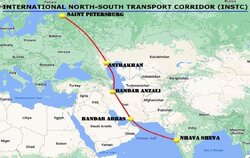
IRISL transports 3,000t of goods along INSTC in 2 months

As IRNA reported, IRISL formed an operational working group for the development of transportation along INSTC in early April and the company has so far allocated 300 vessels to the transportation of goods through this corridor.
The north-south corridor was primarily launched with the aim of transiting goods between India and Europe through Iran; however, it remained in the early stages of execution for many years.
The conflicts between Russia and Ukraine and the special geopolitical situation of Iran in the region have once again laid a suitable ground for the revival of the mentioned corridor; so, this has created a great business opportunity for the Islamic Republic of Iran on the international stage.
Currently, most of the commodities that are transported through Iran along the INSTC are shipments from Russia for India.
Russians and Indians know very well that the transit time of shipping goods on routes through the Black Sea and Suez Canal takes something between 45 and 60 days, and cargoes on these two routes roam 14,000 kilometers from ports of Central Asian countries to East Asian countries which is considered a very long way. However, the same goods reach their destination via the INSTC using Iranian Bandar Abbas and Chabahar ports in only 14 to 15 days which is a third of that time.
To be transited through the north-south corridor, cargos enter northern Iranian ports on the Caspian Sea shores and then transferred by road to the southern ports of the country on the Persian Gulf. From there they are loaded onto a ship and sent to their destinations in East Asia.
Source: Tehran Times


Trump weighs using $2 billion in CHIPS Act funding for critical minerals

Codelco cuts 2025 copper forecast after El Teniente mine collapse

Electra converts debt, launches $30M raise to jumpstart stalled cobalt refinery

Barrick’s Reko Diq in line for $410M ADB backing

Abcourt readies Sleeping Giant mill to pour first gold since 2014

Nevada army depot to serve as base for first US strategic minerals stockpile

SQM boosts lithium supply plans as prices flick higher

Viridis unveils 200Mt initial reserve for Brazil rare earth project

Tailings could meet much of US critical mineral demand – study

Kyrgyzstan kicks off underground gold mining at Kumtor

Kyrgyzstan kicks off underground gold mining at Kumtor

KoBold Metals granted lithium exploration rights in Congo

Freeport Indonesia to wrap up Gresik plant repairs by early September

Energy Fuels soars on Vulcan Elements partnership

Northern Dynasty sticks to proposal in battle to lift Pebble mine veto

Giustra-backed mining firm teams up with informal miners in Colombia

Critical Metals signs agreement to supply rare earth to US government-funded facility

China extends rare earth controls to imported material

Galan Lithium proceeds with $13M financing for Argentina project

Kyrgyzstan kicks off underground gold mining at Kumtor

Freeport Indonesia to wrap up Gresik plant repairs by early September

Energy Fuels soars on Vulcan Elements partnership

Northern Dynasty sticks to proposal in battle to lift Pebble mine veto

Giustra-backed mining firm teams up with informal miners in Colombia

Critical Metals signs agreement to supply rare earth to US government-funded facility

China extends rare earth controls to imported material

Galan Lithium proceeds with $13M financing for Argentina project

Silver price touches $39 as market weighs rate cut outlook

















